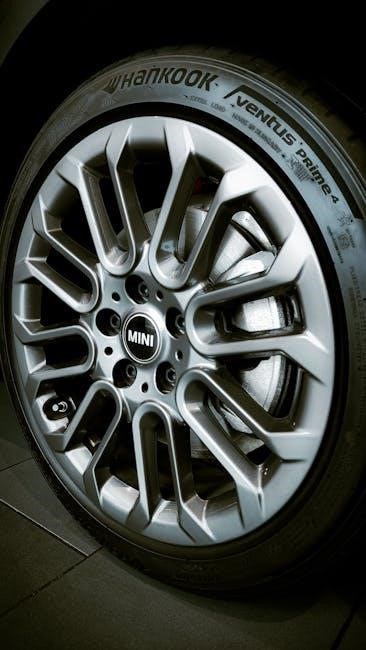Wheel weights are crucial for tire balance‚ typically ranging from 0․25 to 2․1 ounces․ They are clipped or adhesive․
Proper wheel balancing is recommended to ensure optimal driving performance․

Wheel weights are essential for maintaining the balance of a vehicle’s wheels‚ typically ranging from 0․25 to 2․1 ounces․ These small‚ precisely measured devices‚ either metallic or composite‚ are affixed to the rims to counterbalance any irregularities in the tire or wheel assembly․
The primary function of wheel weights is to counteract imbalances that can cause vibrations‚ uneven tire wear‚ and potential damage to suspension components․ Tire shops generally offer two main types: clip-on and adhesive weights‚ each designed for specific wheel types and applications․
Selecting the appropriate wheel weight and ensuring its proper installation is critical for achieving optimal vehicle performance and safety․ Ignoring wheel balance can lead to uncomfortable driving experiences and increased maintenance costs․

Understanding Wheel Weight Types
Wheel weights come in various types․ Two main categories are clip-on and adhesive․ Clip-on weights attach to the wheel flange‚ while adhesive weights stick to the wheel surface․
Clip-On Wheel Weights
Clip-on wheel weights are a traditional method for balancing tires․ They attach directly to the rim flange‚ providing a secure and reliable solution․ These weights are available in various styles‚ such as P/REG‚ designed to fit different rim types․ P/REG weights are commonly used for steel wheels‚ ensuring proper balance and minimizing vibrations․ Choosing the correct clip-on weight is essential for effective balancing․
Incorrect weights can cause damage to the rim or lead to imbalance issues․ Always verify the application with a wheel weight application chart to ensure compatibility․ Furthermore‚ clip-on weights are easy to install and remove‚ making them a convenient option․
Adhesive Wheel Weights
Adhesive wheel weights offer a versatile balancing solution‚ especially for alloy wheels without an outside flange․ These weights attach directly to the wheel surface using a strong adhesive backing․ They are ideal for wheels where clip-on weights cannot be securely fitted or may cause damage․ QuikStikR weights are a popular choice‚ providing reliable adhesion and precise balancing․
When applying adhesive weights‚ ensure the wheel surface is clean and dry for optimal bonding․ It’s also recommended to use coated wheel weights on alloy wheels to prevent corrosion․ Adhesive weights offer a discreet and effective balancing solution․
Steel Wheel Weights
Steel wheel weights are a cost-effective option for balancing wheels‚ offering a balance between price and performance․ While not as malleable as some other materials‚ they provide adequate density for effective balancing․ Steel weights are typically used on passenger vehicles with steel wheels; P/REG style wheel balancing weights are specifically designed for use with steel wheels․
Although steel wheel weights are economical‚ they may be more prone to corrosion compared to coated weights․ Proper installation is crucial to ensure secure attachment and prevent any damage to the wheel․ Always verify application to the wheel type․
Zinc Wheel Weights
Zinc wheel weights are another common choice for wheel balancing‚ offering a good balance of density and environmental friendliness․ Zinc weights are less prone to corrosion compared to steel weights‚ making them a durable option․ These weights are suitable for various types of wheels‚ including steel and alloy․ Always use coated wheel weights for optimal protection against corrosion․
Zinc wheel weights are available in both clip-on and adhesive styles‚ providing flexibility for different wheel designs․ Ensure proper installation to achieve optimal wheel balance and prevent any vibration or uneven tire wear․

Wheel Weight Application
Wheel weight application varies depending on vehicle type․ Passenger vehicles use smaller‚ lighter wheels‚ thus using smaller weights․ Steel wheels should use P/REG style balancing weights․
Passenger Vehicles
Passenger vehicles typically utilize smaller and lighter wheels‚ often constructed from steel or aluminum alloys․ Consequently‚ balancing these wheels requires smaller weights to achieve optimal equilibrium․ The standard weight range for passenger vehicle wheel weights usually falls between 0․25 to 2․1 ounces‚ ensuring precise counterbalancing without adding unnecessary bulk․ These weights are crucial for maintaining smooth driving performance and preventing vibrations that can arise from unbalanced tires․
Proper wheel balancing is essential for passenger vehicles to ensure even tire wear‚ improved fuel efficiency‚ and enhanced overall driving comfort․ Neglecting wheel balance can lead to premature tire degradation and a less enjoyable driving experience․ Therefore‚ selecting and applying the appropriate wheel weights is vital for the longevity and performance of passenger vehicle tires and wheels․ Always consult a professional for accurate balancing․
Steel Wheels
Steel wheels commonly employ P/REG style wheel balancing weights for effective counterbalancing․ These weights are specifically designed to securely attach to the rim flange of steel wheels‚ providing a reliable solution for correcting imbalances․ Steel wheel weights are an economical choice‚ offering a slightly higher density than zinc‚ but they are not quite as malleable․
When selecting wheel weights for steel wheels‚ it’s crucial to use the appropriate style to ensure proper adhesion and balance․ P/REG style weights are generally recommended due to their compatibility with the rim profile of steel wheels․ These weights are designed to withstand the stresses and vibrations associated with driving‚ maintaining their position and effectiveness over time․ Regular inspection and replacement of worn or damaged wheel weights are essential for preserving the balance and performance of steel wheels․
Alloy Wheels
Alloy wheels‚ known for their lighter weight and aesthetic appeal‚ often require a different approach to wheel balancing compared to steel wheels․ For alloy wheels without an outside flange‚ adhesive weights are typically recommended for the outside balance․ Always use coated wheel weights on alloy wheels․ This helps prevent corrosion and maintains the appearance of the wheel․
Some alloy wheels may have designs that make clip-on weights unsuitable‚ making adhesive weights the preferred choice․ Adhesive weights provide a secure and discreet solution for balancing alloy wheels‚ ensuring a smooth and vibration-free ride․
When selecting adhesive weights for alloy wheels‚ it’s essential to choose high-quality products that offer strong adhesion and durability․ Always check brake caliper clearance to the weight with a minimum of 1/8․
Wheels Without an Outside Flange
Wheels lacking an outside flange present a unique challenge for wheel balancing․ Standard clip-on weights cannot be used as there is no edge to secure them․ In these cases‚ adhesive weights are the recommended solution․ Adhesive weights are applied directly to the inside of the wheel‚ providing a balanced distribution of weight without the need for an external flange․
It is crucial to ensure the surface is clean and free of debris before applying the adhesive weights․ This will ensure proper adhesion and prevent the weights from detaching during use․ Some wheels require QuikStikR weights․ Adhesive weights are recommended where there is no flange or the flange is less than 3/16 deep․

Factors Affecting Wheel Weight Choice
Several factors influence wheel weight choice‚ including wheel material‚ rim flange depth‚ and brake caliper clearance․ Selecting the appropriate weight ensures proper balance and avoids any interference with vehicle components․
Wheel Material
The material composition of a wheel—whether steel or alloy—significantly affects the choice of wheel weights․ Steel wheels‚ often found on passenger vehicles‚ typically accommodate P/REG style weights due to their design․ Alloy wheels‚ known for lighter construction‚ are balanced using smaller weights․ Some alloy wheels lack an outside flange and require adhesive weights for external balancing․
Always use coated wheel weights on alloy wheels to prevent corrosion․ Consider the wheel’s material when selecting weights to ensure optimal balance and compatibility․ Passenger vehicles use smaller‚ lighter wheels‚ and small weights will be used for balancing․
Verifying applications is essential‚ so when in doubt‚ always consult expert resources․ The material helps determine the weight type and application method․
Rim Flange Depth
The rim flange depth plays a crucial role in wheel weight selection․ For wheels lacking an outside flange‚ or if the flange is less than 3/16″ deep‚ adhesive weights are recommended․ Some wheels require QuikStikR weights for proper adhesion․ Always verify the flange depth before applying clip-on weights to ensure a secure fit․
Wheels with shallow flanges may not provide sufficient grip for clip-on weights‚ leading to potential dislodgement․ In such cases‚ adhesive weights offer a more reliable solution․ Consider the rim flange depth carefully to achieve optimal wheel balance and safety․
Always verify applications and consult resources when in doubt․ The correct weight type is essential for maintaining balance and preventing damage to the wheel․
Brake Caliper Clearance
Ensuring adequate brake caliper clearance is paramount when selecting wheel weights․ Always check the clearance between the weight and the brake caliper‚ maintaining a minimum of 1/8″ to prevent interference․ Insufficient clearance can lead to friction‚ noise‚ and potential damage to both the caliper and the wheel weight․
Coated wheel weights are recommended for alloy wheels‚ further minimizing the risk of corrosion and ensuring proper fit․ When in doubt‚ always verify applications with a reference chart or consult a professional․ Selecting the correct weight type and size is crucial for maintaining brake system integrity and overall safety․
Regularly inspect wheel weights to confirm they haven’t shifted or caused any contact with the brake caliper․ Addressing any issues promptly will prevent further complications․

DIY vs․ Professional Installation
While tempting‚ DIY wheel weight installation isn’t generally recommended․ Professional installation ensures proper balancing‚ preventing vibrations and uneven tire wear․
Incorrect installation can compromise safety․

Why Professional Installation is Recommended
Professional installation of wheel weights is highly recommended due to the precision required for proper wheel balancing․ Tire technicians possess specialized equipment‚ such as dynamic balancers‚ that accurately identify imbalances and determine the precise weight placement․ This ensures optimal tire performance and prevents vibrations‚ which can lead to driver fatigue and premature wear on suspension components․
DIY installation‚ without the proper tools and expertise‚ can result in inaccurate weight placement‚ leading to continued imbalances and potential safety hazards․ Moreover‚ professionals have experience with various wheel types and weight application methods‚ guaranteeing the correct procedure is followed․ Trusting the experts ensures a smooth‚ safe‚ and comfortable driving experience‚ preserving the lifespan of your tires and vehicle․

Wheel Weight Best Practices
Always use coated wheel weights and check brake caliper clearance with a minimum of 1/8 inch․ When unsure‚ verify applications․
These simple steps ensure safety and optimal wheel performance․
Using Coated Wheel Weights
Coated wheel weights are highly recommended‚ especially for alloy wheels‚ due to their enhanced durability and resistance to corrosion․
Uncoated weights can corrode over time‚ leading to imbalance and potential damage to the wheel itself․
Corrosion not only affects the weight’s accuracy but can also cause cosmetic issues on the wheel’s surface․
Coated weights provide a protective barrier against environmental elements‚ extending their lifespan and maintaining wheel balance․
Always opt for coated wheel weights to ensure long-term performance and prevent premature wear;
By doing so‚ you are not only ensuring the longevity of the wheel weights but also safeguarding the integrity of your wheels․
This simple precaution can save you time and money in the long run‚ avoiding the need for frequent replacements or repairs due to corrosion-related issues․
Investing in coated wheel weights is a smart choice for maintaining the overall health and appearance of your vehicle’s wheels․
Checking Caliper Clearance
Always verify brake caliper clearance with a minimum of 1/8 inch when installing wheel weights․
Insufficient clearance can cause the weight to rub against the caliper․
This rubbing can lead to noise‚ damage to the caliper‚ and dislodging of the wheel weight․
Carefully inspect the area between the wheel weight and the caliper before and after installation․
Rotate the wheel to ensure there is no contact throughout the full rotation․
If there is any contact‚ adjust the weight’s position or use a different type of weight․
Adhesive weights might be a better option if clip-on weights cause interference;
Prioritizing caliper clearance ensures safe and reliable braking performance․
Neglecting this step can have serious consequences‚ affecting your vehicle’s handling and braking efficiency․
Double-check all clearances․
Verifying Applications
When in doubt‚ always verify applications with a trusted resource or professional‚ especially for alloy wheels․
Consult application charts to ensure the correct weight style and placement are used․
These charts provide specific recommendations based on the wheel type and vehicle model․
Using the wrong type of weight can lead to improper balancing and potential damage․
Some wheels require specific weights‚ such as QuikStikR weights for certain applications․
Adhesive weights are recommended where there is no flange or the flange is less than 3/16 deep․
For steel wheels‚ use P/REG style wheel balancing weights․
Alloy wheels without an outside flange should use adhesive weights on the outside․
Always confirm the correct weight range to avoid over or under-balancing the wheel․
Proper verification ensures optimal balance and prevents issues․

Additional Considerations
Consider wheel weight range and the impact of wheel offset․ Lower offset wheels tend to be lighter․
Always consult professionals when unsure about these factors for safety․
Wheel Weight Range
Understanding the wheel weight range is essential for proper balancing‚ especially with varying tire sizes and wheel materials․ The weight typically ranges from 0․25 to 2․1 ounces‚ but this can differ based on the vehicle․
Considering the appropriate weight is vital․ Passenger vehicles usually require smaller‚ lighter weights due to their smaller wheels․ Conversely‚ larger vehicles might need heavier weights․
Always consult manufacturer specifications․ Ensure that the weights are compatible with your rim․
If you are unsure‚ seek professional advice․
Use the correct weight to avoid imbalance․ An imbalance can cause vibrations‚ tire wear‚ and safety risks․
Consider coated wheel weights․ They provide better protection against corrosion․
Always check brake caliper clearance․ Maintain a minimum of 1/8 inch․
Verify applications with a trusted source․
Impact of Wheel Offset

Wheel offset significantly impacts weight distribution and balance‚ influencing the choice of wheel weights․ Lower offset wheels tend to be lighter than higher offset wheels․
Offset affects the wheel’s position relative to the hub․ This affects the torque applied to the wheel bearings․
When changing offset‚ consider the overall weight․ Ensure the wheel is properly balanced․
Incorrect offset can lead to uneven tire wear․ It can also cause handling issues․
Always verify compatibility with your vehicle’s specifications․ This ensures optimal performance․
Consult a professional for guidance․ They can provide expert advice․
Consider the wheel material․ This affects the weight distribution․
Improper offset can affect brake caliper clearance․ Check this carefully․
Use coated wheel weights for corrosion protection․ This will help prolong the lifespan․
Always check brake caliper clearance․ Maintain a minimum of 1/8 inch․




